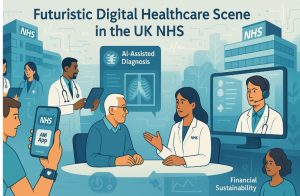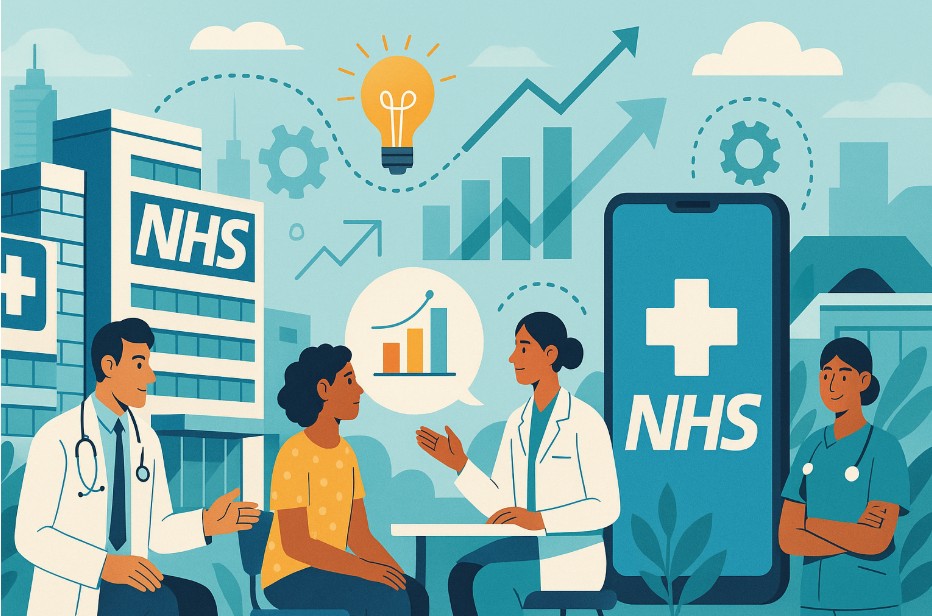The NHS 10 Year Plan 2025 represents a critical turning point for the UK’s healthcare system.
Facing a combination of demographic changes, rising patient demand, technological opportunity, and operational strain, the NHS has recognised the need for transformational change.
This plan outlines a bold vision to future-proof the service, address long-standing structural issues, and deliver more efficient, accessible, and equitable care.
But what exactly does this plan entail? How will it reshape the way health services are delivered across England? Below, we explore the key goals, strategic shifts, and milestones that define the NHS’s path to 2035.
What Is The NHS 10 Year Plan 2025 And Why Does It Matter?
The NHS 10 Year Plan 2025 is a bold reform strategy designed to future-proof the UK’s healthcare system. It reflects the pressing need to address longstanding challenges such as staff shortages, outdated infrastructure, fragmented care delivery, rising patient demand, and persistent health inequalities.
The plan pivots the NHS towards a more decentralised, digitally advanced, and patient-driven model of care.
This comprehensive roadmap is built around three pivotal shifts:
- A move from hospital-focused care to community-based services through the Neighbourhood Health Service model
- A transition from analogue systems to a fully digital infrastructure powered by AI and patient data
- A shift from reactive treatments to preventative healthcare measures
By executing these strategic changes, the NHS aims to become more responsive, efficient, and sustainable while improving access and outcomes for every patient, regardless of socioeconomic background.
How Does The NHS Plan To Improve Patient Care And Outcomes?

Improving patient care and outcomes is one of the most urgent and high-priority goals of the NHS 10 Year Plan 2025. After years of growing patient dissatisfaction, increased waiting times, and inconsistent access to services, the NHS is undertaking a system-wide transformation to redesign how care is delivered across England.
The central focus is on making care more accessible, personalised, integrated, and proactive, rather than reactive.
One of the most transformative aspects of the plan is the establishment of the Neighbourhood Health Service (NHSv2), a new model that shifts the focus of care from hospitals to local communities.
This decentralised structure is designed to bring services closer to people’s homes and streamline delivery through multidisciplinary teams, removing the current fragmentation that characterises much of the system today.
Key Elements Of Care Improvement
The plan outlines a comprehensive package of NHS reforms that aim to improve access, continuity, and quality of care:
- Same-Day GP Appointments: To tackle one of the most common complaints in the system, the NHS will ensure that patients who need it can secure same-day GP appointments. This will be enabled by training thousands more GPs and enhancing digital triage tools.
- Care Personalisation and Planning: For patients with complex or ongoing needs, personalised care will become the norm. The target is to have 95% of such patients covered by a bespoke care plan by 2027. These plans will be co-developed between patients and clinicians and will be accessible through the NHS App.
- Expansion of Personal Health Budgets (PHBs): PHBs allow patients to have greater control over how money is spent on their care. The plan aims to double the number of recipients by 2029 and extend the offer universally to all eligible patients by 2035.
- Digitally Enabled Self-Care: Patients will be empowered to manage their own conditions through the upgraded NHS App, which will include options to book appointments, receive personalised advice, manage medication, track health data, and contact care teams.
Enhancing Continuity and Accessibility
A significant barrier to high-quality care in the current system is poor continuity patients often find themselves repeating their history across services or struggling to access follow-up support.
The NHS 10 Year Plan aims to fix this through an integrated service model that promotes continuity of care, especially for those with chronic conditions.
Neighbourhood Health Centres (NHCs), which will serve as ‘one-stop shops’ for local healthcare, are being developed to anchor community services. These centres will be staffed by multidisciplinary teams including GPs, nurses, pharmacists, mental health professionals, and social care workers. The centres will:
- Operate for 12 hours a day, 6 days a week
- Be located initially in areas with the poorest health outcomes
- Serve as primary hubs for preventive screenings, consultations, and condition management
Preventing Hospital Overuse
One of the most tangible ways the NHS plans to improve patient outcomes is by reducing unnecessary hospital visits and making better use of community-based alternatives.
Hospital services will increasingly focus on high-acuity and specialised care, while day-to-day health management will shift into homes, pharmacies, and community clinics.
To support this rebalancing of care settings, the NHS will:
- Increase access to urgent care in the community, reducing pressure on A&E departments
- Expand the provision of same-day emergency care to keep patients out of hospital when safe and appropriate
- Introduce remote monitoring and virtual wards for chronic disease management and post-discharge care
- Enhance the role of pharmacies in managing long-term conditions, linked directly to a patient’s health record
Empowering Patients Through Technology
A core objective of care improvement is to give patients real control and visibility over their health journey. This will be achieved through an upgraded, centralised digital infrastructure where patients can:
- Book, cancel or change appointments with various providers
- View and share their full health history with any authorised clinician
- Access test results and treatment updates in real time
- Contribute to their own health record with wearable and home-monitoring data
This level of transparency and interactivity is expected to lead to more informed decisions, higher engagement, and better adherence to treatment plans all of which contribute to improved outcomes.
Addressing Barriers To Equitable Care
To ensure that improvements in care reach everyone, the plan also includes specific initiatives to address disparities in health access. Services will be designed with cultural sensitivity, language accessibility, and socioeconomic needs in mind. For example:
- Multilingual digital resources and translation services will be integrated into NHS platforms
- Outreach initiatives will target marginalised communities
- Health education and support services will be delivered in community settings such as schools, places of worship, and public libraries
Metrics To Track Care Improvement
The plan includes detailed performance indicators to track whether these changes are having the intended effect. These include:
- Reduction in A&E visits for preventable conditions
- Increase in same-day primary care appointments
- Growth in uptake of personalised health budgets
- Number of NHCs established and operational
- Reduction in health inequalities measured by regional life expectancy gaps
Below is a table summarising the intended impact on patient care:
| Objective | Expected Outcome by 2025 |
| Same-Day GP Access | Reduced waiting times for primary care |
| Personal Health Budgets | One million recipients by 2030 |
| Integrated Community Services | 12-hour, 6-day-a-week Neighbourhood Health Centres |
| Reduction in Avoidable Hospital Visits | Greater use of same-day emergency care and virtual wards |
| Digital Self-Management | NHS App as the default access point for care |
The NHS 10 Year Plan recognises that delivering better care isn’t just about increasing spending or services.
It is about rethinking how care is accessed, delivered, and experienced with the patient at the centre, empowered by data and supported by a system that is proactive, local, and integrated.
What Are The Top Strategic Goals Of The NHS By 2025?

The NHS 10 Year Plan 2025 outlines a comprehensive vision for transforming the National Health Service to meet the healthcare challenges of the 21st century.
At the core of this vision are strategic goals that address system inefficiencies, outdated infrastructure, workforce shortages, and persistent health inequalities. The plan is designed to not only reform the NHS operationally but also to ensure its long-term sustainability and public trust.
By 2025, the NHS aims to deliver structural and cultural shifts in how services are organised, delivered, and measured. These strategic goals are interconnected and focus on modernising systems, empowering both patients and staff, and aligning the NHS with evolving scientific and technological advancements.
Digital Transformation Of Health Services
One of the foremost goals is the complete digital overhaul of the NHS. While many industries have embraced digital tools to improve customer experiences and operational efficiency, the NHS has historically lagged behind.
The 2025 strategy aims to change that by building the most digitally integrated public healthcare system in the world.
Key elements of the digital transformation strategy include:
- Making the NHS App the central gateway for all healthcare needs by 2028
- Creating a unified, secure patient record system that is accessible across all NHS services and providers
- Expanding remote monitoring, telehealth, and AI-powered diagnostic tools
- Launching HealthStore, a platform offering NHS-approved digital tools and apps to manage conditions
This digital infrastructure is designed to improve care quality, reduce waiting times, enhance patient engagement, and streamline operations across the NHS.
Strengthening The Workforce For Future Healthcare Delivery
The NHS cannot function without a well-trained, motivated workforce. Addressing workforce challenges is a major pillar of the strategic plan. The goal is to reshape NHS careers, provide better training and support, and reduce the current dependence on international recruitment.
The workforce strategy includes:
- Introducing personalised career development plans for every NHS staff member
- Increasing specialty training positions in high-need areas by creating 1,000 new posts
- Offering 2,000 additional nursing apprenticeships in underserved regions
- Embedding AI and digital literacy into all healthcare training programmes
- Reducing sickness absence rates and improving workplace wellbeing
By investing in its people, the NHS aims to become not just the UK’s largest employer, but also one of its most attractive and progressive.
Reducing Health Inequalities Through Targeted Local Investment
Health inequality is a longstanding issue that the NHS 10 Year Plan aims to confront head-on. The strategy focuses on levelling up care access and health outcomes between affluent and disadvantaged communities.
To achieve this, the NHS will:
- Establish Neighbourhood Health Centres (NHCs) in areas with the poorest health indicators
- Allocate funding based on local health needs, rather than standard national formulas
- Deliver culturally competent care and expand outreach in minority and underserved populations
- Increase access to preventative care and screenings in low-income areas
The goal is to halve the life expectancy gap between the wealthiest and poorest regions while raising overall health outcomes for the entire population.
A System Built On Prevention Rather Than Reaction
Another strategic aim is to shift the NHS from a treatment-based model to one that emphasises prevention and early intervention. This means prioritising efforts that reduce the onset of chronic illness, improve lifestyle health, and detect conditions early when they are easier and less expensive to treat.
This preventive approach includes:
- Expanding national screening programmes (e.g. lung cancer, HPV)
- Scaling up vaccination efforts, including universal newborn genomic testing
- Banning tobacco sales for future generations and reducing youth vaping
- Supporting national anti-obesity and healthy eating initiatives
- Introducing incentive programmes to encourage healthier lifestyle choices
By preventing illness before it requires clinical intervention, the NHS can free up capacity, reduce costs, and improve quality of life for millions of citizens.
Introducing A New Value-Based Financial Model
The NHS 10 Year Plan introduces a radically new approach to funding, where resources are aligned with outcomes and efficiency, rather than service volume or historical budget patterns. The financial goals underpin the plan’s commitment to sustainability and accountability.
The updated financial strategy includes:
- Replacing block contracts with performance-based funding models
- Introducing Year of Care Payments (YCPs) to reward long-term health outcomes
- Empowering local systems to retain surpluses and reinvest savings
- Moving towards five-year budgeting cycles to encourage long-term planning
- Withholding payments for poor-quality or underperforming care
The following table outlines how key financial reforms align with strategic healthcare goals:
| Strategic Financial Reform | Intended Impact |
| Year of Care Payments (YCPs) | Encourage preventive and holistic care |
| Outcome-Based Funding | Improve service quality and patient satisfaction |
| Surplus Retention by Trusts | Drive efficiency and local innovation |
| Five-Year Budgets | Enable sustainable planning and reform execution |
| Targeted Local Funding | Address inequalities and meet local needs |
This new funding model is intended to ensure every pound spent delivers maximum value and improved health outcomes for patients.
Enhancing Transparency And Patient Choice
The NHS 10 Year Plan places significant emphasis on empowering patients by giving them more choice, better information, and greater control over their care. A core component of this is increased transparency around provider performance, clinical outcomes, and patient satisfaction.
The plan introduces:
- League tables ranking providers on key metrics such as waiting times, outcomes, and user feedback
- A new patient choice charter to guarantee access to alternative providers
- Tools within the NHS App allowing patients to select clinicians and services based on quality and convenience
- Post-treatment feedback systems that influence future provider payments
This cultural shift towards openness is expected to raise accountability within the NHS and foster competition that drives improvement.
Accelerating Innovation And Scientific Leadership
The NHS aims to place the UK at the forefront of medical innovation. This includes supporting research and adopting transformative technologies such as genomics, AI, and robotics in everyday clinical settings.
The innovation agenda will:
- Expand the use of robotic surgery systems in line with NICE guidelines
- Fund the sequencing of 100,000 newborn genomes and 150,000 adult genomes
- Make wearables standard in chronic condition monitoring and post-acute care
- Launch Health Data Research Service (HDRS) in partnership with the Wellcome Trust
- Establish global institutes to accelerate clinical trial recruitment and data sharing
These developments are designed to speed up diagnosis, personalise treatment, and ensure the NHS benefits from the UK’s strength in science and life sciences.
What Is The Role Of Digital Healthcare And Technology In The NHS Future?

Technology plays a foundational role in the NHS transformation strategy. The goal is to create a fully integrated digital health ecosystem that enhances access, accelerates diagnoses, and personalises treatment.
The NHS App will be central to this effort. It will serve as a comprehensive access point for all services including GP appointments, prescriptions, referrals, and care plans. By 2028, the app will allow patients to:
- Book tests directly
- Select providers based on quality and location
- Access remote consultations and submit health data
- Monitor chronic conditions and manage medication schedules
A single patient record will underpin the system, improving coordination between departments and professionals. Staff will also benefit from AI-powered tools such as scribes and decision-support software to reduce administrative workload.
How Will The NHS Tackle Health Inequalities Across The UK?
Addressing inequality is a cornerstone of the NHS’s long-term vision. The plan identifies key communities disproportionately affected by poor health outcomes including ethnic minorities, rural populations, and low-income urban groups.
Actions to address these disparities include:
- Establishing Neighbourhood Health Centres (NHCs) first in areas with low life expectancy
- Integrating dental, mental, and primary care into single-access centres
- Enhancing the role of community pharmacies in long-term care management
- Expanding screening and prevention in underserved communities
Investment will be guided by local health needs, ensuring that resources reach areas with the highest disparity in outcomes and access.
How Is The NHS Addressing Workforce And Staffing Challenges?
The sustainability of the NHS depends on a well-supported, skilled, and motivated workforce. The plan introduces a modernised staffing strategy focused on flexibility, professional growth, and employee wellbeing.
Key initiatives include:
- Creation of personalised career development plans for all NHS employees
- Introduction of 1,000 new specialty training posts by 2028
- Investment in 2,000 new nursing apprenticeships in high-need areas
- Overhaul of NHS staff standards and contractual frameworks by 2026
Technology will also be deployed to support clinicians. AI assistants will reduce paperwork and administrative tasks, allowing healthcare professionals to spend more time delivering patient care.
What Changes Are Being Made To Integrated Care Systems?
Integrated Care Systems (ICSs) will be responsible for commissioning and managing health services at the local level. This decentralisation aims to bring decisions closer to the populations served and enable region-specific solutions.
Key structural changes include:
- Consolidating NHS England and the Department of Health and Social Care to streamline leadership
- Assigning full commissioning powers to ICSs with an earned autonomy framework
- Aligning ICSs with local authorities to promote joined-up health and social care
- Encouraging the formation of Integrated Health Organisations (IHOs) that can manage entire regional health budgets
These updates are designed to create more agile, transparent, and outcomes-driven healthcare systems across England.
What Funding And Resources Have Been Allocated To The NHS Plan?

Financial sustainability is crucial to the success of the NHS 10 Year Plan. Rather than continuously increasing spending without reform, the strategy introduces value-based budgeting to incentivise better care delivery.
Highlighted below is a breakdown of key financial reforms and resource reallocations:
| Financial Strategy | Objective |
| Value-Based Payments | Link funding to health outcomes, not activity |
| Five-Year Budgeting | Enable long-term planning and accountability |
| Performance Incentives | Bonus payments for high-quality service |
| Surplus Retention | Allow providers to reinvest efficiency gains |
| Shift in Spending Pattern | Redirect funds from hospitals to community care |
The plan also allows NHS trusts to retain proceeds from land sales, introduces funding models like Year of Care Payments, and encourages partnerships with the private sector in areas of greatest need.
What Are The Key Milestones And Metrics To Track NHS Progress By 2025?
To ensure transparency and accountability, the NHS 10 Year Plan defines measurable milestones. These benchmarks help track the pace and effectiveness of reform.
Select performance targets include:
- Reducing elective treatment wait times, with 92% of patients seen within 18 weeks
- Launching a national maternity and neonatal taskforce
- Establishing NHCs in every community with below-average life expectancy
- Rolling out genomic screening for newborns and high-risk adults
- Digitising all hospital and community care records into a single system
Progress will be monitored through annual reports, performance dashboards, and league tables accessible through the NHS App, providing patients and the public with transparent, real-time information.
Conclusion – What does the future of healthcare in the UK look like?
The NHS 10 Year Plan 2025 marks a decisive break from past strategies. Rooted in patient choice, digital innovation, and localised care delivery, the plan reflects the voices of patients and staff who demand meaningful reform.
If successfully implemented, it promises a system that is faster, fairer, and more sustainable one capable of meeting 21st-century demands while preserving the core principles on which the NHS was founded.
Frequently Asked Questions
What is the difference between the NHS Long Term Plan and the 10-Year Health Plan?
The Long Term Plan (2019) focused on high-level reforms over a decade, while the 10-Year Health Plan (2025) sets out more urgent, structural changes with a focus on sustainability, digital innovation, and prevention.
How will rural communities benefit from the NHS 10 Year Plan 2025?
Rural areas will receive investment in Neighbourhood Health Centres, mobile services, and digital tools to reduce travel needs and increase healthcare accessibility.
What are the risks and challenges associated with the NHS reform?
Challenges include workforce resistance, funding limitations, digital divide among patients, and regional disparities in service delivery capacity.
Will there be private sector involvement in NHS services by 2025?
Yes, the plan maintains that private providers will be used to expand capacity, particularly in disadvantaged areas, under NHS standards and oversight.
How does the NHS plan address ageing population health needs?
By investing in preventative care, wearable monitoring, and specialised community services, the plan aims to reduce hospital admissions and prolong healthy life expectancy.
What role does prevention play in the new NHS strategy?
Prevention is central via smoking cessation, obesity control, mental health support, vaccinations, and early disease screening all aligned to reduce future healthcare burdens.
How often will the NHS review progress on the 10-year plan?
Progress will be reviewed annually, with updated reports, performance dashboards, and public transparency metrics.








